Luxembourg 2024 "Europa-2024: Underwater flora and fauna"
| <prev | back to index | next> |
| Issue Date | 14.05.2024 |
| ID | Michel: 2368-2369; Scott: ; Stanley Gibbons: ; Yvert: ; Category: pR |
| Designer | illustrations: Jean-Marie POISSENOT, stamp layout: GAM (LU) - graphic design agency |
| Stamps in set | 2 |
| Value |
L50g (€1.00) - Ichthyosaur E50g (€1.40) - Plesiosaur |
| Emission/Type | commemorative |
| Issue place | Luxembourg |
| Size (width x height) | 40mm x 33mm |
| Layout | Two Sheets of 10 self-adhesive stamps |
| Products | FDC x1 |
| Paper | |
| Perforation | 13,25 x 13,50 |
| Print Technique | 4 color offset lithography |
| Printed by | Cartor Security Printing, France |
| Quantity | |
| Issuing Authority | POST Philately |
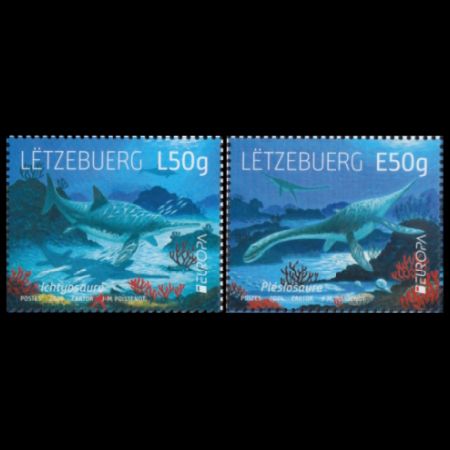
On May 14th, 2024, the Post Authority of Luxembourg, issued the set of two self-adhesive stamps "Europa-2024: Underwater flora and fauna". These stamps show two underwater animals who were contemporaries of dinosaurs:
- Ichthyosaur (Leptonectidae indet.) shown on the stamp with the face value "L50g" which is equivalent to the rate of domestic letter with weight up to 50g.
- Plesiosaur (Microleidus melusinae) shown on the stamp with the face value "E50g" which is equivalent to the rate of Europe wide letter with weight up to 50g.
"Luxembourg" at that time looked much different than it does today.
During the Early Jurassic, the giant continent of Pangaea started to break apart.
The land area of Central and Western Europe consisted of many small islands, surrounded by shelf seas (with a maximum depth of 200 meters), which are therefore flooded with light, warmth and rich in species.
The majority of "Luxembourg" lay under such a sea, a small part in the north was part of a land mass that stretched from the Rhineland to southern England. Beside these big prehistoric reptiles, the sea was populated by squid, ammonites, bony fish, sharks, and crocodiles.
Some of these prehistoric marine animals were depicted on stamps of Luxembourg in 1984.
Note:
The first articulated skeletons of both prehistoric marine reptiles:
Ichthyosaur and
Plesiosaur were discovered at
the beginning of nineteenth century by British fossils collector
Mary Anning, who is often called "the first professional fossils-hunter"
and whose 225th anniversary of her birth occurred in 2024.
The British Royal Mail used this opportunity to
commemorate Mary Anning and some of
her most famous fossils on their postage stamps.
The "Europa-2024: Underwater flora and fauna" stamps of Luxembourg were designed by the French artist Mr. Jean-Marie POISSENOT.
Jean-Marie POISSENOT - after he finished art school at Epinal and the National School of Art in Dijon, Mr. POISSENOT started to work as an illustrator in Paris. Today his works can be seen in "Musee d'Archeologie in Strasbourg Musee de La Tour aux Puces" at Thionvil and the "Musée national d'histoire naturelle - 'natur musée" in Luxembourg. Mr. POISSENOT also Illustrated some books for the Luxembourger Ministry of Education.
Mr. POISSENOT worked with acrylic technique, after he made some pencil sketches in black-white and created some color proofs.Acrylic provides more vibrant colors, some of which are highly bright, properties that most other materials can’t match. Acrylic dries fast to become irreversibly insoluble, making it ideal for creating rich details and random effects.
Jean-Marie POISSENOT is a prolific illustrator who has illustrated many children and fiction books for many publishers, including Gallimard jeunesse, Nathan, Hachette et Casterman. Some works of Mr. POISSENOT can be seen in European museums, but this was the first time he designed postage stamps.
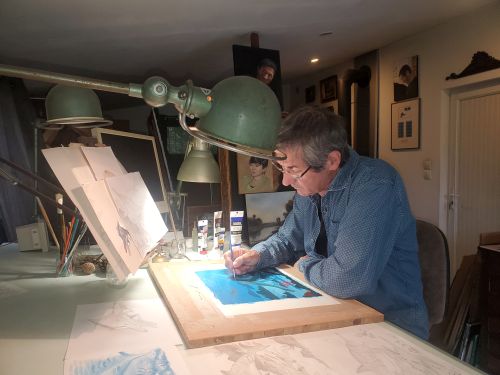 |
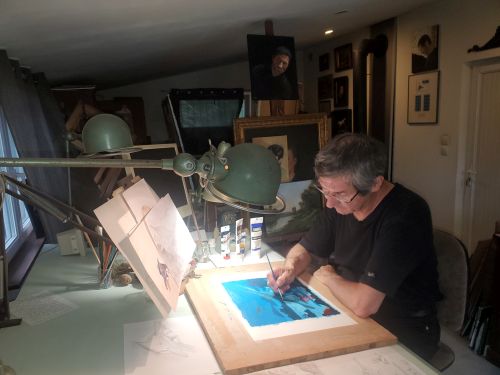 |
| Jean-Marie POISSENOT on the work of the stamps "Europa-2024: Underwater flora and fauna" of Luxembourg 2024. The photos were provided by Mr. POISSENOT. | |
The presentation ceremony of these stamps took place at the "Musée national d'histoire naturelle - 'natur musée" (MNHN LU). Two souvenir frames, with both Mini-Sheets and FDC, were presented by Mr. Mario Treinen, Director of POST Courrier and Mr. Claude Balthasar, Head of Patrimoine & POST Philately, to Mr. Patrick Michaely, Director of the MNHN LU, and Mr. Jean-Marie POISSENOT.
This was also an opportunity for Dr. Ben THUY, curator of the Museum, to talk about the remarkable excavation of an ichthyosaur fossil in the early 2020s at the Cloche d'Or, rue Émile Bian.
 |
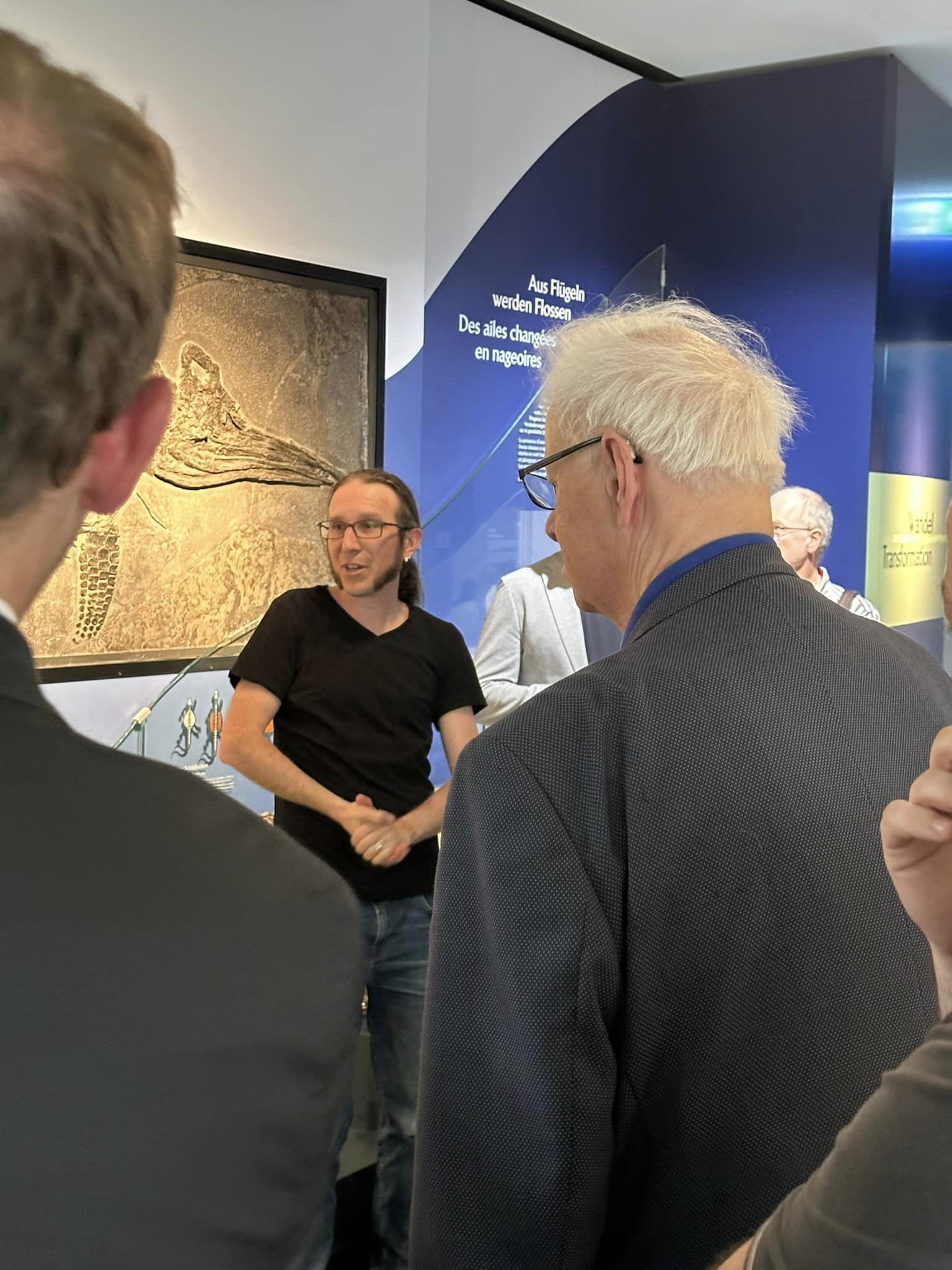 |
|
Presentation of EUROPA - Underwater Fauna and Flora stamps of Luxembourg 2024
in Musée national d'histoire naturelle - 'natur musée. From left to right: Mr. Claude Balthasar, Head of Patrimoine & POST Philately; Mr. Jean-Marie POISSENOT the artist who created the stamps; Mr. Mario Treinen, Director of POST Courrier; Mr. Patrick Michaely, Director of the Museum; Dr. Ben THUY, palaeontologist, curator of the Museum. Image credit: POST Philately |
The paleontologist of the museum, Dr. Ben THUY in front of an Ichthyosaur
fossil, describes the prehistoric underwater animals of Luxembourg. Image credit: facebook profile of the Museum |
The following prehistoric animals were depicted on the stamps
Ichthyosaur
Ichthyosaurs ("fish lizards") are an extinct group of aquatic marine reptiles (not fish nor lizards), who belong to the order Ichthyosauria.
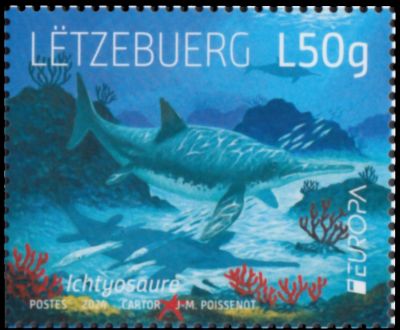 |
| Ichthyosaur on stamp of Luxembourg 2024, MiNr.: 2368, Scott: . |
The ichthyosaurs through convergent evolution evolved a fish-like body adapted for living in water exclusively.
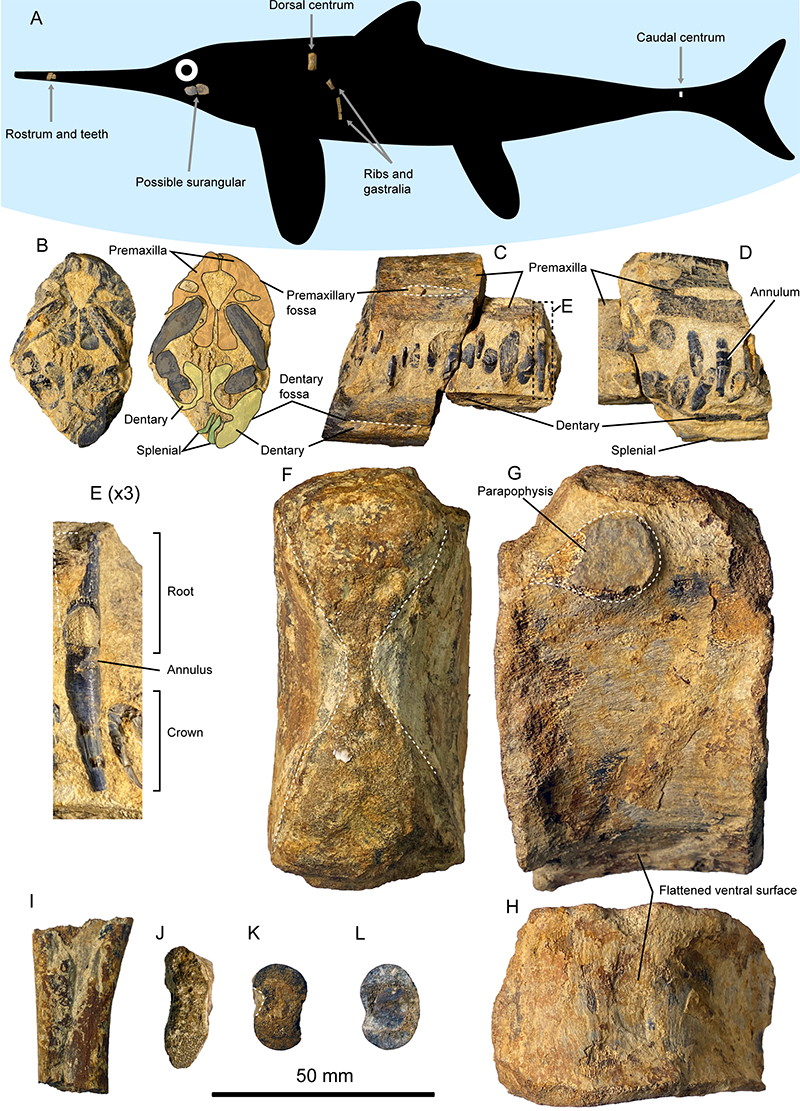 |
| Fossils of Ichthyosaur in the collection of the Museum, the specimen number MNHNL LM266. The image was provided by curator of the Museum, Dr. Ben THUY. |
The eyes of ichthyosaurs were very large in relation to their body length and surrounded by a ring-shaped, bony reinforcement, the Sclerotic Ring, which occurs in many vertebrates.
More about Ichthyosaurs and the history of their discovery is here.
The first fragments, of the Ichthyosaur in Luxembourg, were found during preliminary inspections in April 2021, at a construction site near the local water tower at emerging Cloche d'Or business centre to the south of Luxembourg City. Most of the remains were collected during controlled excavations and led by several paleontologists of "Musée national d'histoire naturelle Luxembourg - natur musée" (MNHN LU) in July 2021, complemented by subsequent finds cropping out after the millennial floods of summer 2021.
Many articulated and disarticulated remains of an Ichthyosaur, including ribs and a tooth were discovered (see on the right).
These bones were found in the Pliensbachian strata (the age between 192.9 to 184.2 million years ago) and were estimated to be 190 million years old.
Initially, these fossils were assigned to Temnodontosaurus, but in the later review, they were assigned to the family Leptonectidae, representing a single individual.
Leptonectidae is a family of ichthyosaurs known from Late Triassic to Early Jurassic marine deposits in Europe. They were all small to medium-sized creatures, most noted for their very long, swordfish-like snouts, which could have been used as a weapon, slashing through schools of fish.
Due to the fragmentary nature of the fossils, it is impossible to assign these bones to any species, therefore the Ichthyosaur was listed as Leptonectidae indet. (indeterminate).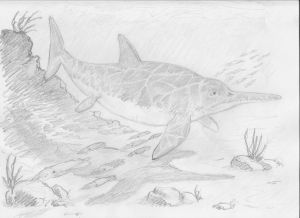 |
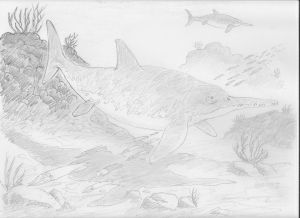 |
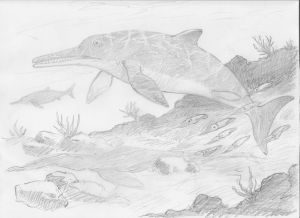 |
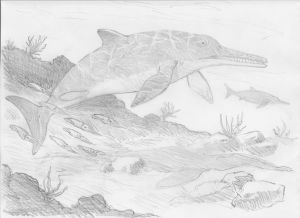 |
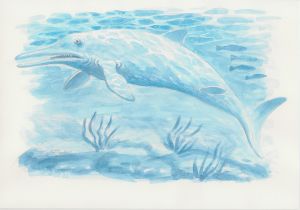 |
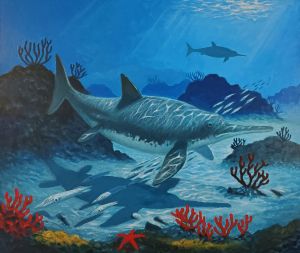 |
| Sketches of the Ichthyosaur stamp created by Mr. Jean-Marie POISSENOT for POST Philately of Luxembourg in 2024. Image credits: provided by Mr. Jean-Marie POISSENOT. | ||
Plesiosaur
Plesiosaurus (near to lizard) is a genus of extinct, large marine sauropterygian reptile that lived during the Early Jurassic. It is distinguishable by its small head, long and slender neck, broad turtle-like body, a short tail, and two pairs of large, elongated paddles.
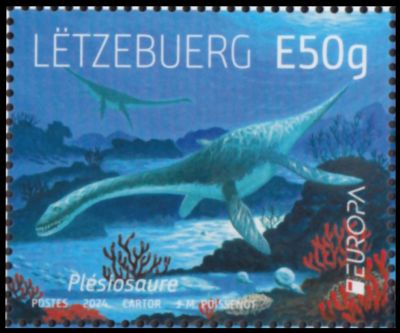 |
| Plesiosaur on stamp of Luxembourg 2024, MiNr.: 2369, Scott: . |
The almost entire skeleton, including skull, of plesiosaur was collected by amateur fossil collector, René Hirtz, during construction works for electric pylons of the Pétange-Belval line, in 1980s - 1990s, at almost equal distance from the localities of Sanem and Soleuvre in the south of Luxembourg.
They remained in the basement of Mr. Hirtz home, in the rock without anyone noticing its unique character and scientific importance for their paleontological heritage.
After his death, in 2010, a volunteer researcher at "the National Museum of Natural History of Luxembourg" (MNHN LU), who was called to inspect the fossil collection of Mr. Hirtz, realized, that the fossil could be something special.
"It was not in its current condition," explains Robert Weis, paleontologist at the MNHN LU. "The skeleton was in a calcareous nodule; you could make out the outlines, but only an expert would see anything other than a few stones in it."
The Museum acquired the specimen in 2012, then sent it to Natural History Museum in Stuttgart in Germany, where preparator Oliver Kunze spent over 200 hours peeling the fossil out of the limestone. Due to the fact, the bones were spread over several rocks and some bones were broken, it was a big puzzle to construct them together into the skeleton.
 |
| Plesiosaur reconstruction in collection of the Museum. The image was provided by curator of the Museum, Dr. Ben THUY. |
Microleidus melusinae was about 2.5 meters long and lived about 180 million years ago. Its hind and front extremities had the shape of swimming fins. They had an elongated body, a long neck and a relatively small head. The trap-like teeth and the long neck suggest that Microleidus melusinae was a predator. It fed on smaller cephalopods and schools of fish, which it probably hunted by swinging its head back and forth and eating the creatures that got caught in its small, sharp teeth.
Since 2017, the skeleton has been on display in the permanent exhibitions of the Museum (specimen number MNHNL TV434 - see the photo below), where it illustrates the evolution of marine reptiles. As it represents one of the rare plesiosaurian specimens from that stage found outside of the United Kingdom and Germany, and one of the rare plesiosaurian specimens from Luxembourg, many paleontologists from around the world have come to Luxembourg to study the unique fossil.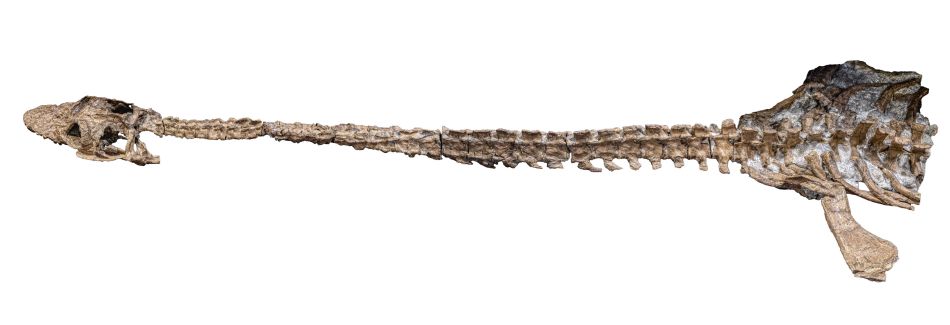
Plesiosaur skeleton in collection of the National Museum of Natural History, specimen number MNHNL TV434. The image was provided by curator of the Museum, Dr. Ben THUY.
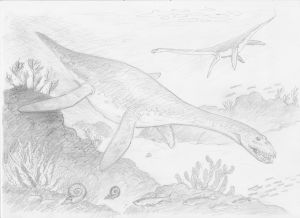 |
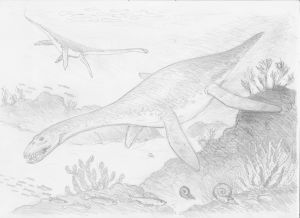 |
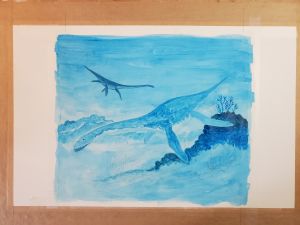 |
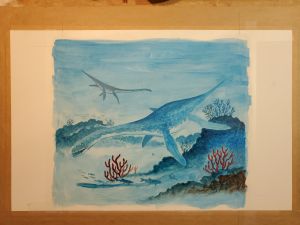 |
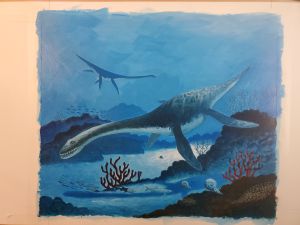 |
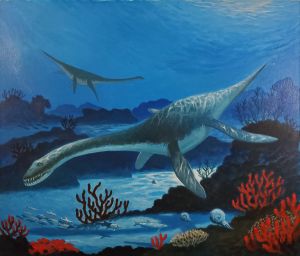 |
| Sketches of the Plesiosaur stamp created by Mr. Jean-Marie POISSENOT for POST Philately of Luxembourg in 2024. Image credits: provided by Mr. Jean-Marie POISSENOT. | ||
Musée national d'histoire naturelle Luxembourg - natur musée (in English the National Museum of Natural History)
The museum belongs to the Society of the Natural Sciences, which was established in 1850, under the patronage of Prince Henry, the newly appointed Governor of Luxembourg representing Grand Duke William III. The society's primary aim was the promotion of the natural sciences and natural history to the general public. To achieve this, the government put at the society's disposal a section of the city Athenaeum, now the National Library. Opening its doors in 1854, this area hosted a number of cabinets displaying fossil specimens, spread across three rooms. Since then, the museum moved several times, from one location to another.
Today, the museum is located in the Grund quarter on the eastern bank of the Alzette river, next to the Neumünster Abbey cultural centre in the Luxembourg City.
The museum is composed of eight separate scientific sections, spanning the natural sciences: botany, ecology, geology and mineralogy, geophysics and astrophysics, palaeontology, vertebrate zoology, and invertebrate zoology.
Completely renewed permanent exhibitions reopened their doors in June 2017 covering more than 1000 m2. The brand new museological and museographic concept reflects the state of research in natural history in general and that of the museum's rich collections in particular, thus providing a global perspective on current topics such as biodiversity and evolution.
In addition to its permanent exhibition, the museum regularly hosts special and focused exhibitions all about plants, animals and the universe. An interactive multimedia system as well as an ecological database connects the visitor to the natural sciences, plants and animals of the Grand Duchy.
Two videos, where curator of the Museum Dr. Ben THUY describes the Ichthyosaur and Plesiosaur fossils from collection of the museum. The audio is in German and Luxembourgish (no video with English audio found to date).
Note: the Ichthyosaur skeleton on the wall of the museum, shown in the videos, is from famous a German fossil location - Holzmaden, not from Luxembourg.
Several thousand well-preserved ichthyosaurs have been found at Holzmaden (north-west from Ulm in Germany) since the 1880's and prepared by the technicians at the Museum. They can be seen in many museums at home and abroad, including Luxembourg. The most beautiful specimens were kept by Berhnard Hauff for display in his own museum. It opened in 1937 and was replaced by a modern building in 1971.
Products and associated philatelic items
| FDC (clean and circulated) | ||
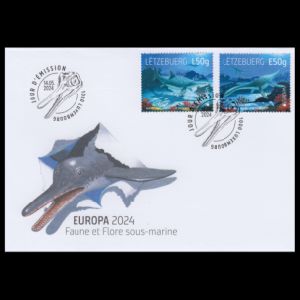 |
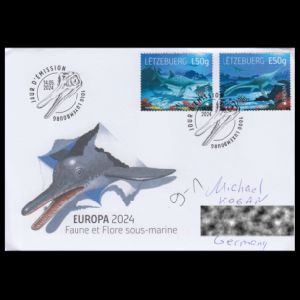 |
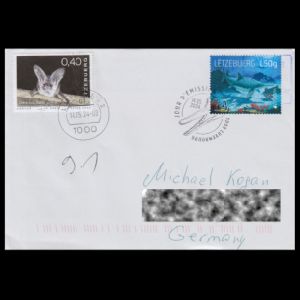 |
| Sketches of the FDC cachet | First-Day-of-Issue Postmark | |
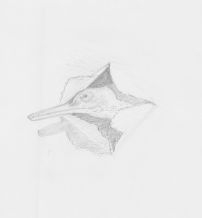 |
 |
 |
| Sketches of the FDC cachet created by Mr. Jean-Marie POISSENOT for POST Philately of Luxembourg in 2024. Image credits: provided by Mr. Jean-Marie POISSENOT. | ||
| Maxi Cards | Example of circulated covers | |
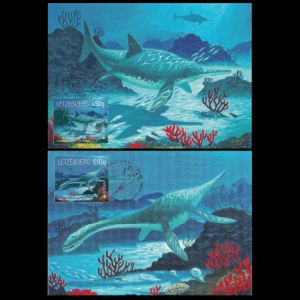 |
 |
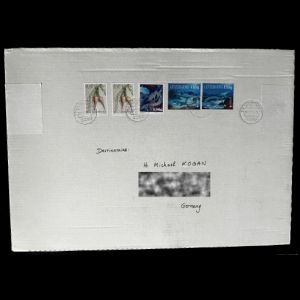 |
References:

|
- Technical details and official press release:
- POST Philately: ichthyosaur stamp, plesiosaur stamp, the postmark, presentation ceremony.
- colnect,
- Jean-Marie POISSENOT (the artist): official website (many pages are broken, but the gallery is fine)
- GAM (graphic design agency): official website
- Musée national d'histoire naturelle Luxembourg - natur musée: official website, facebook, Wikipedia, Luxembourg-city.
- Ichthyosauria (general information):
- "The History of the Discovery of Ichthyosaurs", by Michael Kogan and Dr. Peter Voice
- Wikipedia
- Encyclopedia Britannica
- Ichthyosaur discovery in Luxembourg:
Luxembourg Times,
Palaeontologia Electronica.
- Leptonectidae: Wikipedia,
- Plesiosaur (general information):
- Plesiosaur discovery in Luxembourg:
Delano,
Science LU,
RTL LU:
[1],
[2], including video in French and German.
- Microcleidus: Wikipedia,
- The Lost Ocean (reconstruction of life in Jurassic sea at Luxembourg): WoXX (in German),
Acknowledgements:
- Many thanks to Mr. Jean-Marie POISSENOT for explanations about his work on the design of the stamps and for providing photographs.
- Many thanks to Dr. Ben THUY, and Dr. Robert Weis from the Musée national d'histoire naturelle Luxembourg - natur musée for providing details about the discovery of the fossils and for providing images.
- Many thanks to Dr. Peter Voice, PhD Department of Geological and Environmental Sciences, Western Michigan University, USA, for reviewing of a draft of this article.
| <prev | back to index | next> |